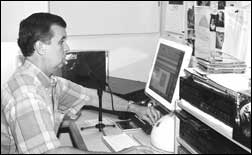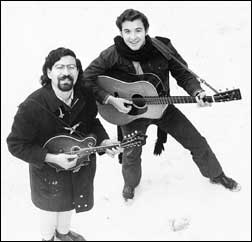|
|

PHOTO
BY DIANE CHIDDISTER
Local resident Fred Bartenstein working in his studio at his home
on Wright Street. Earlier this month WYSO started airing Bartenstein’s
bluegrass program, ‘Banks of the Ohio,’ on Saturday’s
from 6 to 9 p.m.
|
| |

PHOTO BY JULIA SINCLAIR
Fred Bartenstein, right, with mandolinist Bob Applebaum
at Harvard in 1970. |
’YSO
host spins love of bluegrass
Most local residents
know Fred Bartenstein as a reasonable, low-key organizational consultant,
the guy often called in to facilitate public meetings and local conflicts.
He’s the picture of calm, the one in the middle who keeps people
on track and lowers rising tensions and deepening voices.
But Bartenstein has
another life, and there’s nothing reasonable or low-key about it.
It’s a life fueled by his lifelong passion for something not often
associated with straightlaced organizational consultants, or with CEOs,
which he used to be. More than anything, Bartenstein loves bluegrass music.
“It’s
a gift I have, a knowledge I have,” Bartenstein said in a recent
interview. “I had the good fortune to have been involved young with
bluegrass at a central place where a great deal of music was happening.
Now I’m trying to teach the rich story of where the music came from
and where it’s going.”
Bartenstein has recently
begun sharing his love of bluegrass in a local venue. Since early July
his radio show, “Banks of the Ohio: Music from the Homeplace of
Bluegrass,” has aired each Saturday evening from 6 to 9 p.m. on
91.3 FM, WYSO public radio. The show took the place of the long-running
“Bluegrass Breakdown,” whose host, Aaron Harris, recently
left the station to return to school.
Produced in the WYSO
studio or in Bartenstein’s home studio, “Banks of the Ohio”
has for a year been broadcast on BluegrassCountry.org, a 24-hour Internet
music stream from WAMU in Washington, D.C. The show is also an outreach
program for the International Bluegrass Museum in Owensboro, Ky.
While villagers may
be unfamiliar with Bartenstein’s bluegrass expertise, through his
Internet program bluegrass fans worldwide know his name. Regularly, he
hears from listeners from many countries and continents, from Australia
to Ireland, from a farmer in Kansas to a woman living alone in a remote
cabin in Alaska.
“It’s
really fun — it’s addictive — to know that something
I’m doing is reaching all these odd corners of the world,”
said Bartenstein, who answers all e-mails.
Bluegrass music is
currently experiencing a resurgence, Bartenstein said, explaining that
he believes many people find in it a heartfulness lacking in some other
music forms.
“Bluegrass
evokes a sense of the genuine in an era where a lot of art is about image
or pose,” he said. “It talks about nature and home and family
in ways that resonate with people. Bluegrass songs tell stories.”
When they hear bluegrass
for the first time, many people feel an immediate attraction to the sound
of the music, Bartenstein said. The “keening” quality of bluegrass
seems to connect to some at a deep level, he said, and sounds similar
to bluegrass can be found throughout the world in music as diverse as
Hungarian folk music and Japanese koto music.
“There’s
something about the rhythm and the sound of the banjo, mandolin and fiddle
together,” he said. “It’s a driving, exciting rhythm.
It appeals to people viscerally.”
Bartenstein can’t
remember the first time he heard bluegrass — he just always remembers
loving it. Raised in New Jersey, he spent summers on his grandparents’
Virginia farm, where he remembers hearing Red Smiley and the Bluegrass
Cut-Ups every morning on the radio. His father and an uncle played in
a guitar-mandolin duo, and a cousin from Tennessee taught Bartenstein
at a young age the songs of the famous Carter family.
His years at a private
New Jersey high school coincided with a thriving bluegrass scene in New
York City, where, in Washington Square Park, Bartenstein played bluegrass-style
guitar with musicians such as Tex Logan, Bob Applebaum, Pete Wernik and
David Grisman. While still in high school, Bartenstein hosted a bluegrass
radio show out of Lexington, Va., where he also gave the farm report.
Bartenstein’s
connection with bluegrass became even more personal when he attended at
age 15 the nation’s first bluegrass festival, which took place in
Fincastle, Va. His love for the music deepened even after an experience
that might have turned off some fainthearted music lovers, recounted in
an article on Bartenstein in Bluegrass Unlimited magazine.
Sitting around jamming
with other musicians, Bartenstein was confronted by a drunk who stumbled
toward him and waved a gun. The drunk insisted the musicians play “Foggy
Mountain Breakdown,” and threatened to “blow our heads off”
if he didn’t like it, according to Bartenstein. Thankfully, the
music met with the man’s approval.
Through a series
of coincidences, at the next year’s festival, Bartenstein was called
upon to emcee the show. For the next several years he helped run a variety
of bluegrass festivals, working as program director, emcee and sometimes
running the sound as well, the magazine reported.
When it came time
to attend college in the late 1960s, Bartenstein chose Harvard University,
largely due to its location in the middle of a thriving bluegrass scene
in Boston, according to the magazine.
“It was a strange
time to be doing bluegrass but then, as now, it was my community,”
Bartenstein said. “It was a college subculture and compared to the
drug scene, it was a healthier, smarter and generally a much better alternative.”
His love of bluegrass
also shaped Bartenstein’s professional plans, when he chose in 1975
to settle in Dayton partly due to the city’s reputation as a place
that drew bluegrass to an urban area. Bluegrass proliferated in the Dayton
area when Appalachian natives looking for work began settling here, bringing
along their preferences for mountain music, he said.
After Bartenstein
decided he didn’t want the life of a professional musician and chose
to work in the corporate world, he held a series of high-visibility jobs,
as the director of the Victory Theater, Books & Company and the Dayton
Foundation. But he maintained his passion for music and hosted a series
of bluegrass radio programs at stations such as Dayton’s WONE, WYSO
and WBZI in Xenia.
Having one foot in
the corporate world and the other rooted firmly in bluegrass often made
Bartenstein feel slightly schizophrenic, he said. Once he was walking
down the street in Dayton, dressed in a suit and tie, when he was stopped
by an acquaintance who was a business executive. The man marveled that
he had just heard a man on the radio, with the same name and same voice
as Bartenstein, hosting a bluegrass show. The man never even considered
that the radio host might actually be him, Bartenstein said.
The discomfort of
leading a double life diminished after Bartenstein and his family —
his wife, Joy, and two daughters — moved to Yellow Springs in 1990.
Purposefully getting off the corporate fast track, he opted to train as
an organizational consultant, and has since worked with many local and
regional businesses. Bartenstein said he especially appreciates the variety
of his latest work and having the opportunity to spend more time with
his wife. He also appreciates being able to live almost within view of
cornfields in a town he considers lively and stimulating.
And of course, there’s
bluegrass. His flexible work schedule gives Bartenstein more free time,
but his bluegrass passion eats that time right up, he said. Currently,
he estimates that he spends about 20 hours a week working on his WYSO
show, including researching material, programming, writing promotional
copy, editing and doing post-production work.
“I haven’t
figured out a way to make it pay diddly,” he said with a shrug.
“It soaks up a huge part of my week.”
But Fred Bartenstein
doesn’t really sound as if he minds all that much.
“I feel like
I have a wonderful life,” he said. “I live in a beautiful
place and I do work that I love. I’m always learning new things.”
And he gets to sit
in his Wright Street house in Yellow Springs and share his lifelong passion
for bluegrass with people all over the world.
—Diane
Chiddister
|



